In my last post I discussed a set of five masks from Santa María Peñoles, Oaxaca, that were used in the Dance of the Dead. I contrasted this dance to another, the dance of the Matarachín, which will be the subject of today’s discussion.
I will begin with a brief overview. As noted in my last post, Todos Santos/the Day of the Dead occurs each year on November first, although there is local variability regarding the days that specific spirit visitors might be expected, such as infants and children on one day and adults on another. Dances and celebrations related to Christmas follow in December. For example the Totonacs celebrate el Niño Perdido (the finding of the lost Christ child) each year on the evening of December seventh, there are specific Totonac dances about the birth of Christ later in the same month, la danza de Lakapíjkuyu and la danza de Lakakgolo, and all of Mexico entertains the singers of Las Posadas from December sixteenth through December twenty-fourth.
La danza de Matarachín is said to begin on Todos Santos and then to unfold more elaborately on the octava, on the eighth day of November. This second part goes on for three days and ends with the unmasked dancers visiting the cemetery, where their steps trace the shape of a cross. Only at the very end of this phase does the Matarachín dancer appear and perform.
In passing, I have observed this dance practice of the dancer making the sign of the cross with his feet in another setting. Obviously this is something that was introduced by the Christian missionaries. It is my impression that this signing occurs when devoutly Christian dancers are impersonating evil dance characters; the dancers reaffirm to God their true beliefs, using their feet.
Such reaffirmation may seem necessary because the masked personages who dance in this performance pretend to represent the malignant dead. Such characters can appear in Mexican dances at All Souls or during Carnaval (or Mardi Gras); apparently their original purpose was to propitiate or otherwise fend off any genuine evil spirits that might have thought it necessary to visit. However the major character, El Matarachín, is unique to this localized dance, which occurs in the area of Veracruz around Papantla, in such towns as El Espinal and Paso de Valencia.
As you will later see, the published descriptions of this dance refer to the perspective of duality or dualism as a likely key to understanding its meaning. These words can refer to opposing concepts such as good versus evil or to a fundamental belief within a polytheistic religious system that the fate of the universe is determined by conflict between several gods (or groups of gods), who are engaged in an eternal struggle for dominance. In contrast Christianity rejects such a view, insisting that God is the one and only ultimate power.
I discovered the relevance of these concepts during the writing of my book about the masks and dances of the Sierra de Puebla. Despite the appearance that the Indians of the Sierra de Puebla had accepted Christianity, overtly converting from polytheism to monotheism, the available evidence suggested the opposite possibility during some interim period. How else could one explain the Miguelitos dance in which Christ and Satan are presented as equals sparring for power, when Christian doctrine portrays God and Christ as omnipotent and Satan as powerless. For their relationship to have been so dramatically adjusted, these personages must have been somehow redefined by the dualistic perspective found within the traditional indigenous religious system of that region.
What was that system? The traditional Indian gods of Mexico had multiple aspects and each aspect could have a different name, creating the appearance of a cluster or team of gods. This is analogous to the Christian concept of the tripartite God—Father, Son, and Holy Spirit, but with an important difference. While the three Christian manifestations of God (the trilogy) are considered to be in perfect alignment, the multiple aspects of the Indian gods often demonstrated a variety of goals and styles and each of these aspects (or personalities) might have unstable or conflicted behaviors. Thus dualism does not only refer to conflict between gods but also to conflict within a particular manifestation of a god.
The two great Aztec gods of the Sierra de Puebla were Quetzalcóatl and Tezcatlipoca and they were indeed perceived as frequently in conflict about the control of the universe, although occasionally they were said to work together to accomplish some great task. Based on the perception of similarity or of shared features, the Indians appear to have identified Christ as yet another manifestation of Quetzalcóatl. Thus Guy Stresser- Péan, a distinguished French anthropologist (2009, e.g. 515), described a group of linked Totonac deities that included the sun, el Niño (an alter ego of Quetzalcóatl), and Christ. The Europeans did the same thing in reverse, by immediately announcing that Tezcatlipoca was really Satan.
This comparison and connecting of Indian deities with Christian deities and related figures probably occurred soon after the European missionaries arrived and initiated conversion. Exploring this aspect, I found suggestive evidence that Tezcatlipoca had also been provided with some new connections through this process. Traditionally this god had more than twenty manifestations, but he seems to have picked up a few more that reflect European personages, namely Pilatos (based on Pontius Pilate), and Satan.
Both Pilatos and Satan appear as characters in the Matarachín dance. It is said that one can recognize Pilatos by either his remarkable smile or his alarming angry frown. Here is a mask of the smiling Pilatos. He was collected in Paso de Valencia (a town where the Matarachín dance has been documented to occur) in about 1970, and with a history of use during the season of Todos Santos, so this is Pilatos from the danza de Matarachín.
This is a wonderful mask. Shari Cavin (Cavin-Morris Gallery) sold this to me from her personal collection in 1995. Note the carefully carved ears.
Look at the beautiful wear on the back of this mask.
The creation of these expanded deities had an important consequence—the Indians could continue to recognize the dualism involving their forbidden traditional gods by including in their dances scenes of conflict or tension between aspects of those gods that were drawn from the Christian tradition, such as Christ and Satan, San Miguel and Satan, or even San Miguel and Pilatos. It seems that the original names (such as Tezcatlipoca) were gradually forgotten over the centuries that followed this shift in naming, creating the illusion of full Christian conversion. Yet Christ and Satan appear to have retained persistent identities as agents in dualistic balance.
I am convinced that something like this did occur. Not only do Christ and Satan depict surprising equality in the danza de los Miguelitos, but there they also demonstrate unexpected personality traits. Christ does not dictate to Satan, instead they negotiate, even though this leads to surprising compromise. For example, after Christ had criticized Satan’s practice of eating all of humankind every seven years, they agreed that Satan would reduce this by half! On the other hand Satan is portrayed as a man of the people and a defender of the weak. Such strange plots are only easy to understand if these figures are perceived as agents in a dualistic balance (and therefore as extensions of Quetzalcóatl and Tezcatlipoca).
The dance of the Matarachín includes images of characters that are related to Tezcatlipoca, such as Satan and Pilatos, but it lacks images suggestive of Christ or the sun. However, there is an implicit comparison between these two sets of deities due to the juxtaposition of the Matarachín performance between Todos Santos and Christmas, along with the obvious fact that the imagery of one is the opposite of that of the other. That is, as I will more fully explain later, the Matarachín exemplifies evil, darkness, and deformity while Christ and his saints symbolize light, perfection, and grace. Thus it seems that this dance is involved in a dualistic relationship with Todos Santos proper and with the dances and ceremonies of the Christmas season.
Investigation of those Christmas dances adds further insight. In a paper by Zeferino Gaona Vega and Facunda Juárez Hernández (December 2003) about “La Danza de Lakapíjkuyu en las Posadas del Municipio de Coxquihui, Veracruz” (reprinted in Entre los Hombres y las Deidades: Las Danzas del Totonacapan), the authors began with a legend. Until the birth of Jesus, the world was dark, but at the moment of his birth an extremely bright star appeared. There were people and animals who apparently understood that the light was a gift from this newborn baby, so they gathered around him. A second version of this story states that the human visitors came dressed as animals, some to worship the infant, others to rob or kill him. Suddenly the sun rose. The myths don’t clearly explain what happened next, but it seems that some visitors were admitted to proximity with the baby and others were not, based on the intentions of the visitor. The Lakapijkuyu dancers represent those who were admitted. Those who were not admitted were somehow defined as outsiders and transformed into the animals that they were portraying, then they had to find refuge in the mountains. They are said to be represented by the viejos in a second Christmas dance, that of the Lakakgolo. Apparently the Matarachín was at one time included in the Lakakgolo dance, although now he has a separate dance. From this report it would seem that these three dances are closely related, but by differences or contrasts rather than similarities. The dualistic tensions between them are palpable.
Therefore I do not regard the dance of the Matarachín as a strict expression of All Souls day, but rather as a hybrid performance that reflects the earlier holiday and simultaneously, albeit in an unexpected fashion, anticipates the events of Christmas.The Lakapíjkuyu legend underscores the duality of light versus darkness and the associated duality between Christ and el Matarachín. But because the Matarachín has two heads, he is himself a symbol of duality.
More generally, I have come to believe that in this region the dualistic conflict between these two gods (Quetzalcóatl and Tezcatlipoca ) or their respective proxies (such as Christ and Satan) is either expressed directly within every dance or expressed more covertly by the juxtaposition of pairs of dances.
I owe my understanding of this dance to a valuable book, Entre los Hombres y las Deidades: Las Danzas del Totonacapan. This book contains essays (in Spanish) by Mexican anthropologists about the dances in the Totonacapan, the area that was once the home of the Totonac nation, although now the Totonacs share this region with Nahua and Otomí Indians. Not only was this was my source for the legend about the Lakapíjkuyu dance, but also three essays within this book describe la danza de Matarachín, two in the section on Todos Santos and Carnaval and the third in the section about the dances related to Christmas. That in itself is strange, a further clue to the ambiguous nature of this performance.
Rubén Croda León is the author of the essay “El Matarachín y los viejos” (2005, 149–152). There he reported that the dancers are referred to as Viejos or Huehues. I should explain that there are at least two kinds of Huehues. On the one hand, there are those who would otherwise be called Tejoneros, as found in the Dance of the Huehues or Chéncheres that I discussed in earlier posts; they seem to represent, among other things, the ancient spirits of the trees and the forested mountains. It is not said that they represent the dead. But then there are other Huehues, also called Viejos or Viejitos, who explicitly portray the dead. We met such a Viejo in last weeks post. These characters dance during Todos Santos and Carnaval in the Huasteca, where they are sometimes called Xantolos. In the Totonac area of Veracruz the Viejos dance as characters in the Matarachín dance. It is far less clear whether they also dance in Carnaval. To add to the confusion, there are also Viejos, Viejas, and Viejitos in other Mexican dances, for instance in the Viejitos dance in Michoacán.
Regarding the Huehue characters in the Dance of the Matarachín, Croda León (2005. 149–152) provided this description: “Los huehues son la personificación de los difuntos, son los antepasados, las animas que vagan por las calles y bailan ante los altars de las casas del pueblo proporcionando un poco de diversion a cambio de óvolo que consiste en comida, bebida o dinero.” (The Huehues are the personification of the deceased, they are the ancestors, the souls that wander the streets and dance before the altars of the town, providing a little diversion in exchange for offerings that consist of food, drink, or money.) He described a long list of characters that are depicted by the dancers, noting that some seem ordinary and others fantastic. These include el diablo (the devil), la muerte (death), el brujo (a wizard), as well as a soldier, a foreman, a doctor, a professor , an herbalist, an athlete, and the Matarachín.
Here are three masks that were carved by José Gonzalez Hernandez, a mask maker who lives in Comunidad Morelos, Veracruz. He identified these as Viejitos or Huehues for the Matarachín dance.
This finely detailed Viejito mask was carved in about 1980 by José Gonzalez Hernandez.
The small and relatively infrequent pinholes on the face suggest that this mask was carved from wood that had already suffered minor infestation with boring insects. There is no damage to the carved features of the face to suggest a serious infestation after the mask was completed. Note the beautiful ears.
This finely detailed mask had been heavily used over a period of 25 years before it was collected in 2005.
Here is a second Viejito mask by the same carver. It could also be danced in Carnaval.
With its long nose, this mask has an amusing appearance. It is less finely carved in comparison to the other two masks by this carver.
Although this mask was carved in about 1990, and collected from the carver in 2008, it does not appear to have been danced much.
The next mask, “Viejito Lorenzo,” was carved in 1980 and collected in 2005.
The first mask and this one both have elaborately carved ears in an identical design.
This Viejo or Viejito mask has also had heavy use.
<text>The Matarachín figure is most easily described in terms of the process that prepares him to perform in this role. A slender and, it is hoped, flexible young man lies on his back on the ground, his arms extended above his head. He is wrapped with a blanket and this is tied in place with a rope, leaving only his hands and his feet exposed. Then one mask is tied to his hands, another to his feet. He is said to resemble a gusano, a two-headed worm. If he bends sharply at the waist, for instance by doing a sit-up, the two masks will clack together, nose to nose. The mark of a skillful dancer is his ability to rapidly alternate between extending and bending his body, so that the masks repeatedly tap and separate. Having explained all this, Croda León (2005,149–152) ended by stating that the Matarachín’s two heads demonstrate the principle of duality.
Here is a pair of masks that were worn by the Matarachín dancer in El Espinal, Veracruz, from about 1994 until 2009, when one of the masks split in two as a result of fifteen years of repeated impact with the other mask.
Here is the replacement set that was carved in 2009, danced for one year in El Espinal, and collected in 2010.
Note that the replacement masks had already suffered damage after one year of use—the nose of one and the chin of the other.
The backs of these masks do not have much contact with human sweat, so they do not demonstrate patina.
In a separate essay, “El Matarachín, rito del dios dual,”Roberto Williams García (2005, 148–149) described his experience of traveling to a place near Paso de Valencia, Veracruz, in the mid-1980s to witness the Matarachín performance. His account is similar to that of Croda León. Note the reference to dualism or duality in the title of his essay. There is the perception of a duality between the two heads, one normal and the other abnormal.
In her essay, “La danza de Matarachín,” which is found in the section of the book about the dances of Navidad (Christmas), Ygnacia Hernández Vázquez (2005, 130–131) provided a myth about the origin of this dance. A rebellious daughter became pregnant out of marriage, so her parents threw her out of the house. She gave birth to her son in the open, and in total darkness. He was born with two heads. His parents initiated a dance for his healing and he became normal. In this author’s version, the cast of characters included El turco (a reference to a Turk or Moor), the foreman, who was dressed in black and wore a black mask. There was a bebe (infant); that was the “two-headed worm.” The infant’s father was named Matarachín and his mother, Ursula. There were Viejos who wore masks and hats with horns.
Hernández Vázquez made some interesting further points: “Esta danza únicamente actúa fuera de la casa durante el periodo que corresponde a las posadas, de diez de la noche a una de la mañana, aproximadamente. Se considera que es una danza del mal, que representa todo lo malo. En ella también pudiera estarse representando a Tezcatlipoca, el dios todopoderoso, multiforme y ubicuo, dios negro del cielo nocturno, patorno de los hechiceros y los malvados.” [This dance only takes place outside the house and during the period from ten at night to one o’clock in the morning, approximately. It is considered to be a dance of evil, which represents all that is bad. Alternatively it could be representing Tezcatlipoca, the all-powerful, multiform and ubiquitous god, black god of the night sky, patron of wizards and evildoers] (2005, 130–131).
Later I will show the mask of a Brujo (wizard) that I am attributing to this dance.
Hernández Vázquez echoed the other authors by referring to the principle of duality (2005, 130–131): “En la danza del Matarachín se encierra el principio de la dualidad, del bien y del mal, del día y la noche, posibles reminiscencencias de la concepción Mesoamerican acerca de la existencia de un dios luminoso, Quetzalcóatl, y uno de la oscuridad, Tezcatlipoca.” (In the Dance of the Matarachín the principle of duality is embedded, of good and evil, the day and the night, possibly reminiscent of the Mesoamerican concept about the existence of a luminous god, Quetzalcóatl, and a dark one, Tezcatlipoca.)
When Hernández Vázquez suggested that the principle of duality was embedded in the dance of the Matarachín, she seemed to be making a connection between that dance and those from Christmas, such as that of the Lakapíjkuyu, essentially speculating that the Dance of the Matarachín occurs in apposition to the celebration of Christmas. In the latter, one celebrates a baby of light and perfection, in the other an infant of darkness and deformity. There appears to be a duality between these two babies. It was apparently this contrast that caused Hernández Vázquez to recall the classic Mexican beliefs regarding the duality between those two great gods—Quetzalcóatl and Tezcatlipoca.
I purchased the next mask from Jaled Muyaes and Estela Ogazon in 1997. It had been collected in about 1970 and was labeled as a “Huehue, Veracruz.” It is likely to be a Huehue from el danza de Matarachín. I particularly like the sagging eyes, which suggest death, and the beautiful tubular mouth. This is a majestic old mask.
The back of this mask shows excellent patina.
The next mask had been in a private collection in La Union, Veracruz. The owner called it a Brujo or witch. As noted earlier, the brujo is an identified character in the dance of the Matarachín.
The Brujo mask also has well-carved ears.
Once again, this is another fine old mask with great patina.
In 2009, the Gobierno del Veracruz published a beautiful book of photographs of dances and folklore in that state—El Arte de Ser Totonaca. There was also an edition in English—The Art of Being Totonac. This is a strange book, because the photographs are superb, but they lack captions. There are wonderful photos of the Matarachín dance on pages 224-227. I found the dancers from the photos in Zozocolco de Hidalgo, Veracruz. The leader of the dance group, Leonardo Carcamo Palomino, informed me that there was not an actual Matarachín figure in that version of the dance. The dancers wore remarkable tall crowns. In this version the characters in the dance are Reyes Malos (Evil Kings).
Here we see Leonardo Carcamo Palomino on the left, his son Isias on the right, and their friend Alejandro Segura in the middle—Malinche, flanked by the two “evil kings.” I thank Leonardo Carcamo Palomino for allowing me to take this photo and the next.
Next is a group of masks worn by the Evil Kings in the Zozocolco version of the danza de Matarachín.
Here is the Diablo mask that was worn by Isias Carcamo Palomino, Leonardo’s son, in the Zozocolco de Hidalgo Matarachín group. I obtained it from Leonardo Carcamo Palomino.
Note the dramatic goat’s ears that identify this mask as the devil—Satan
Here is a Diablo from Colonia del Valle, Puebla, a community that is near the border with Veracruz. This devil mask was used during Todos Santos and represents a dead person, but I don’t believe that it was part of the dance of the Matarachín. It was carved by Lucio Borniento Iturbide.
The back shows mild wear.
I hope that you have enjoyed this introduction to the dance of the Matarachín. As far as I know it is unique to a small area of Veracruz. Next week I will show a Moor mask that I found on EBay™.

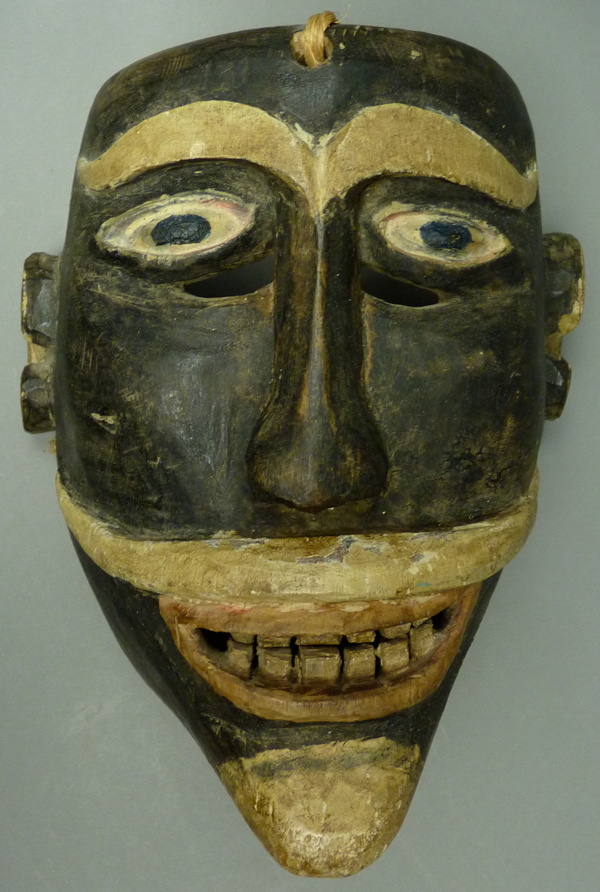
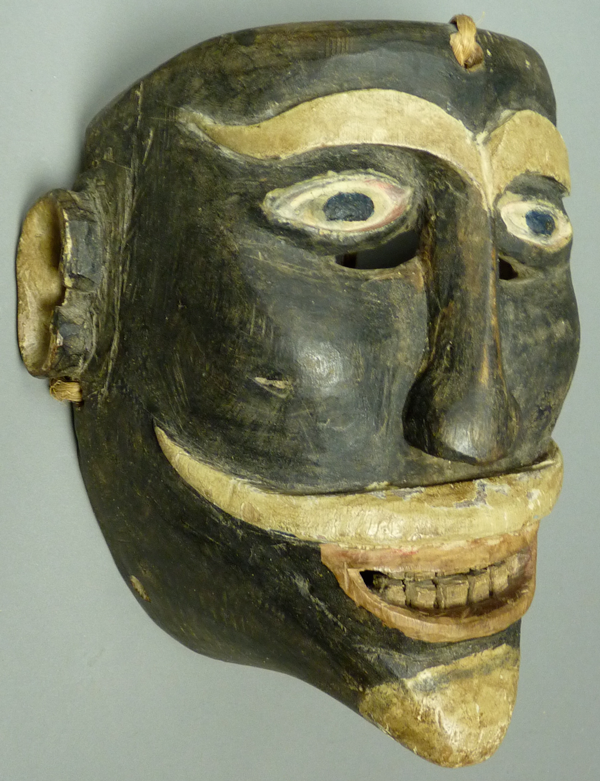
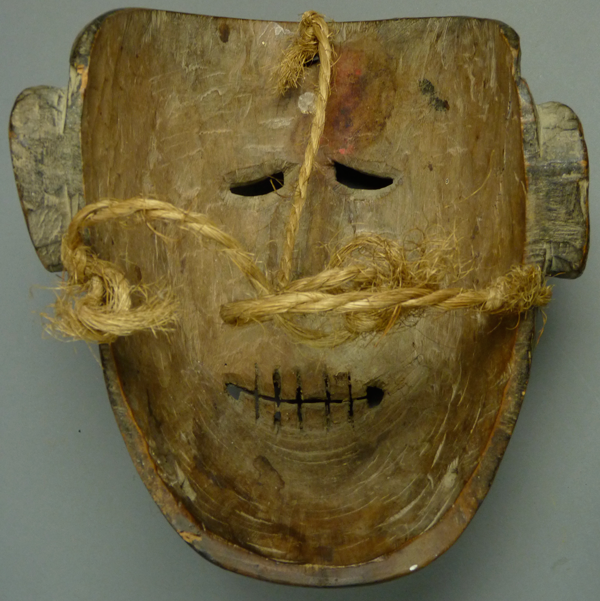
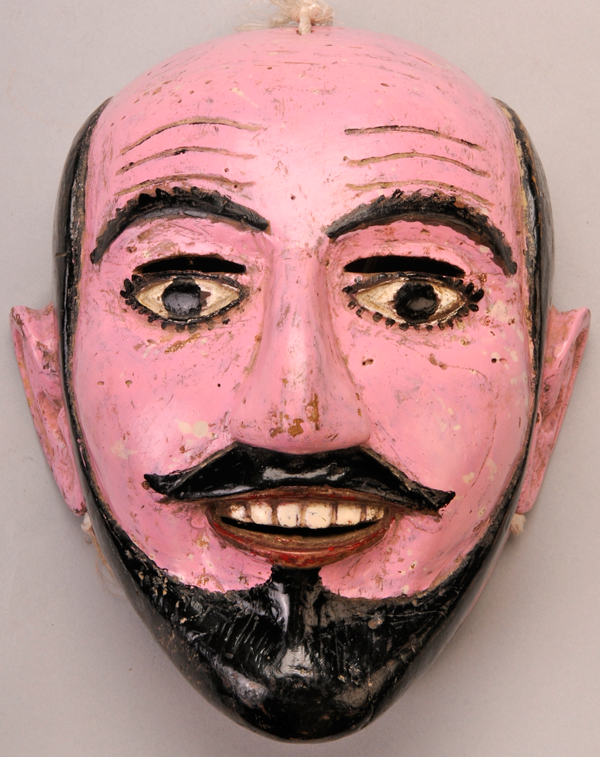
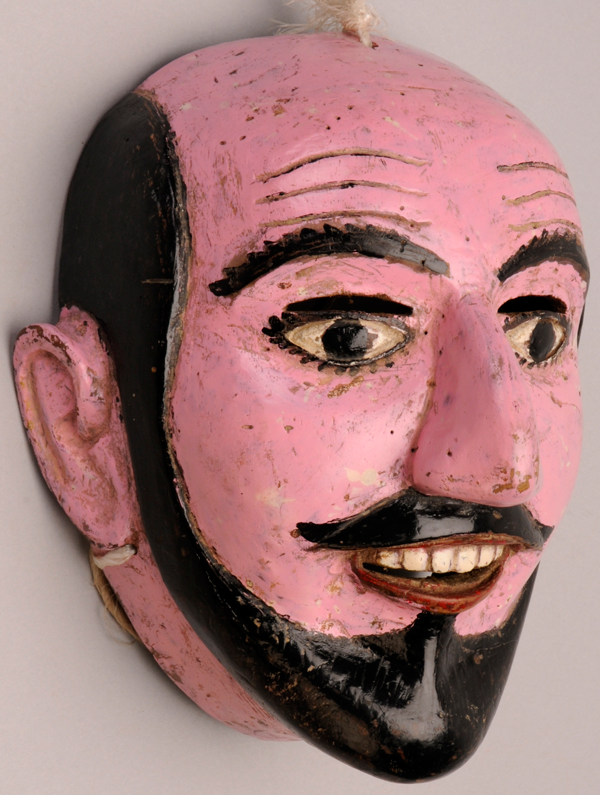
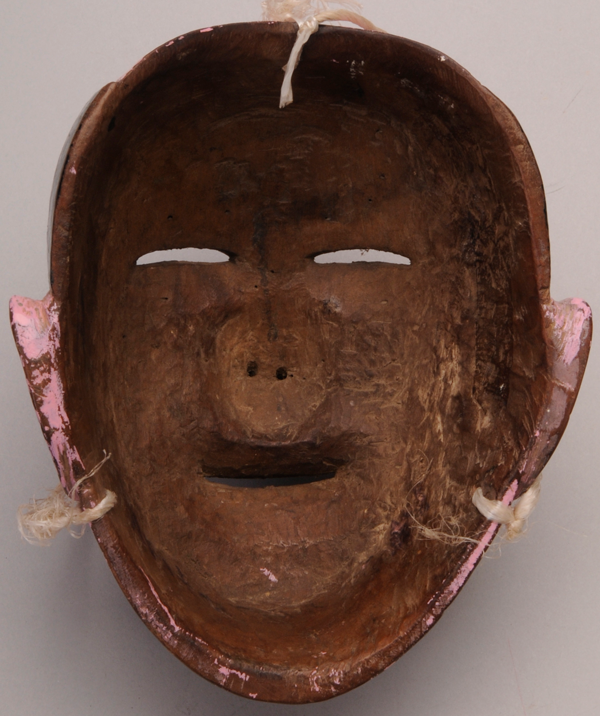
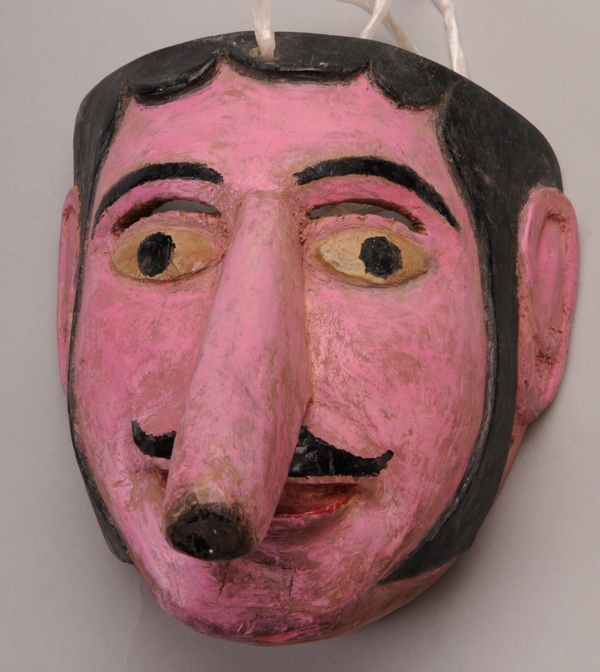
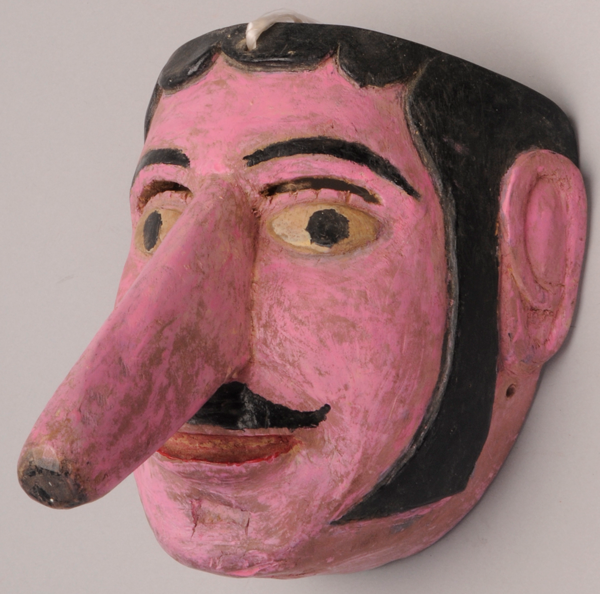
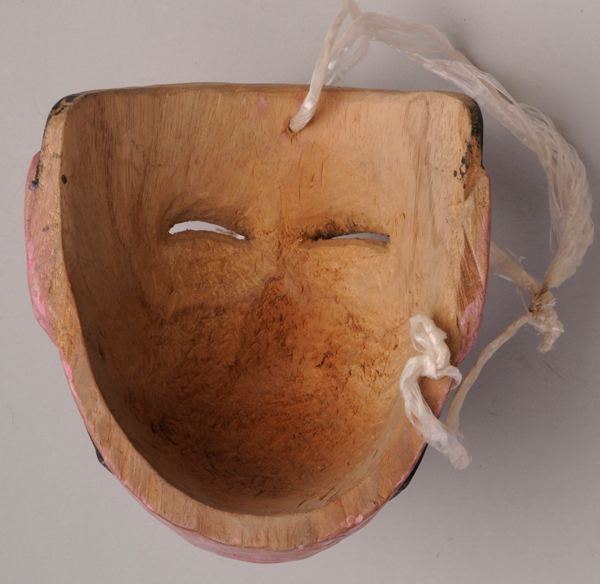
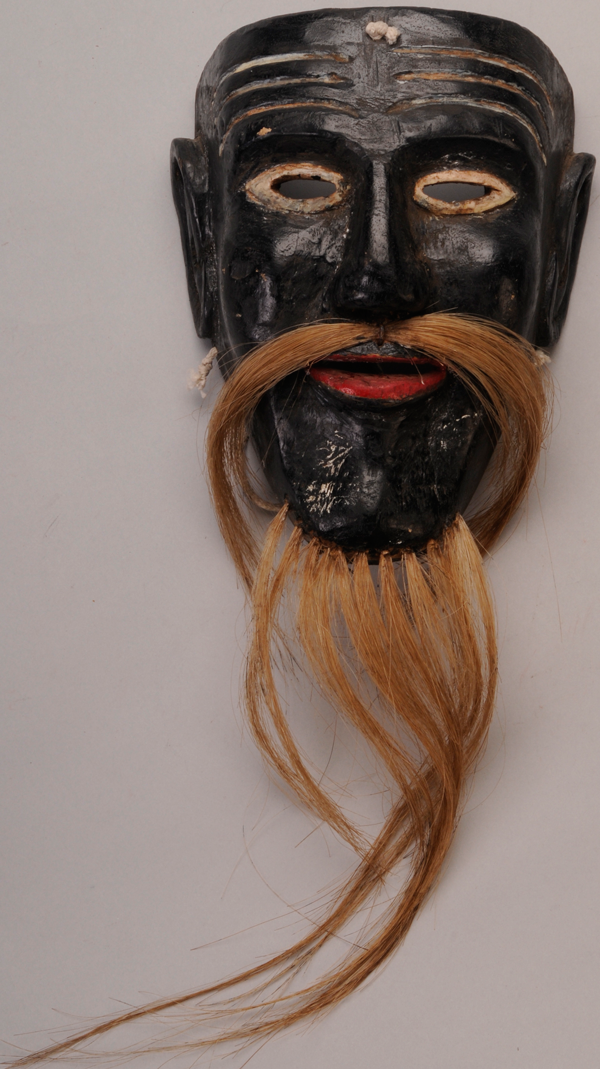
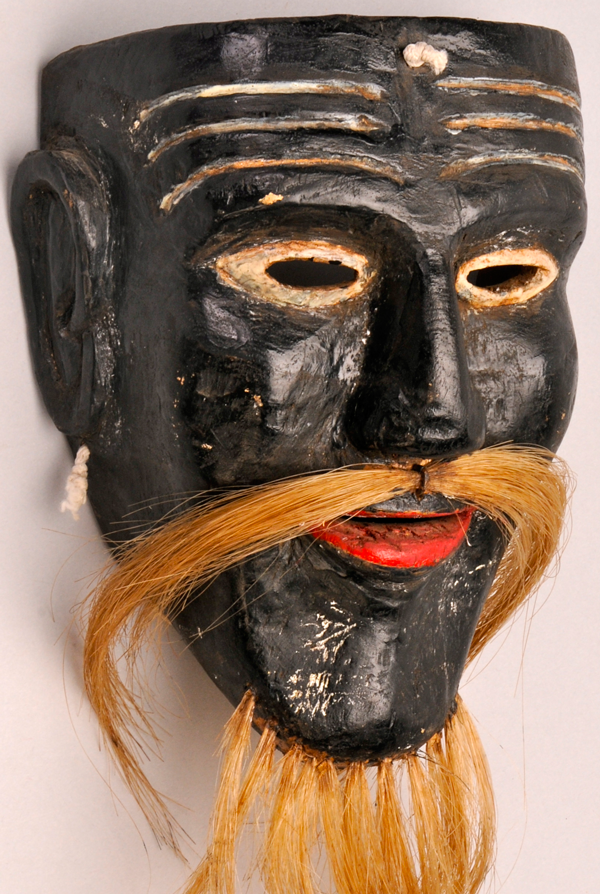
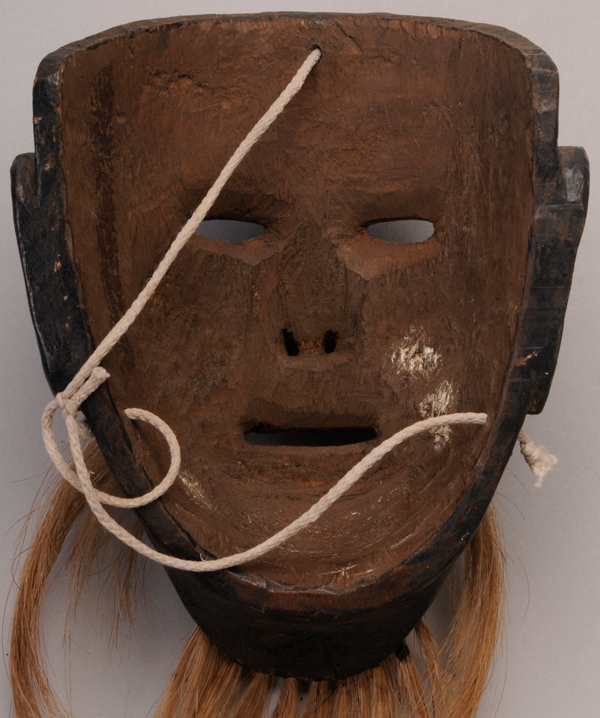
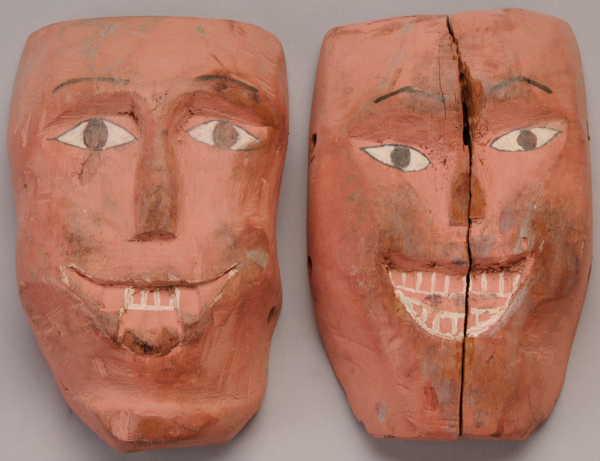

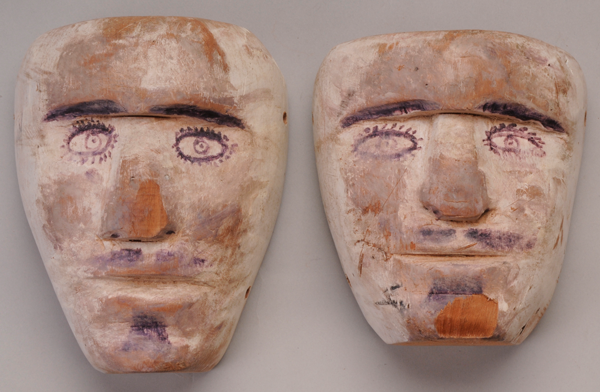
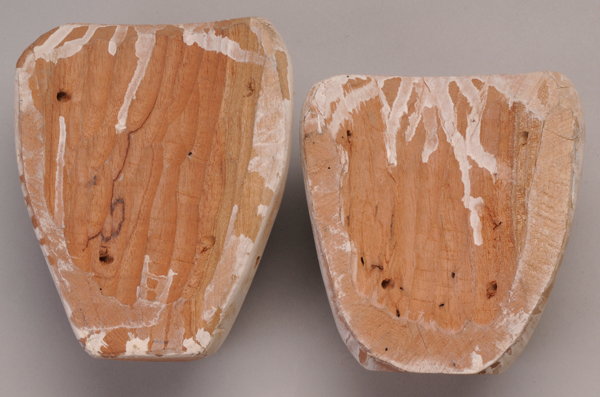
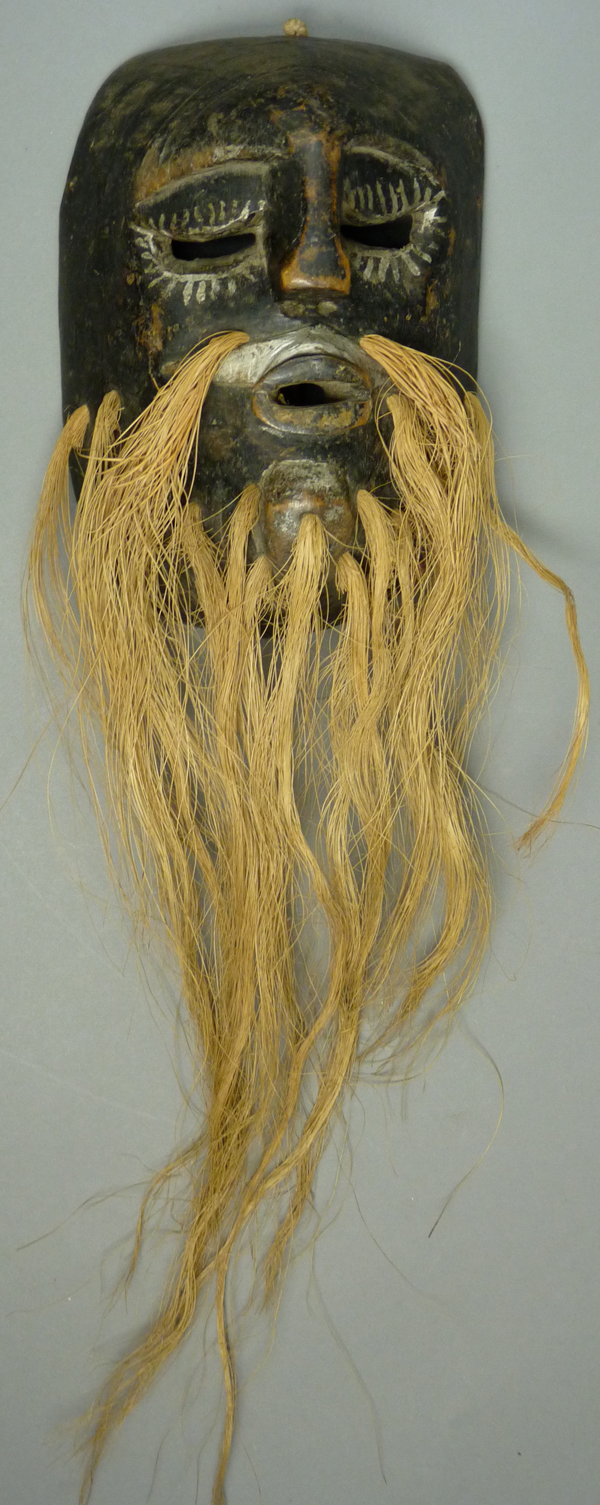

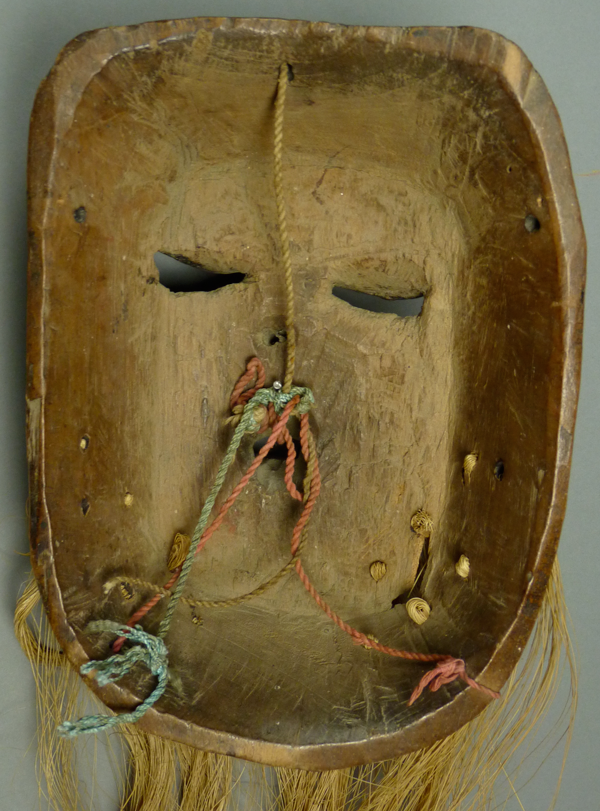
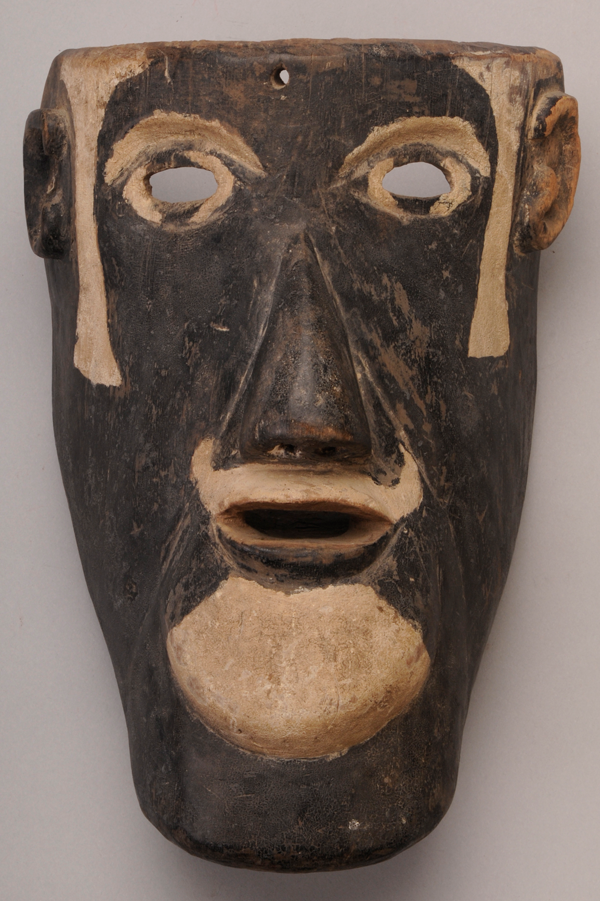
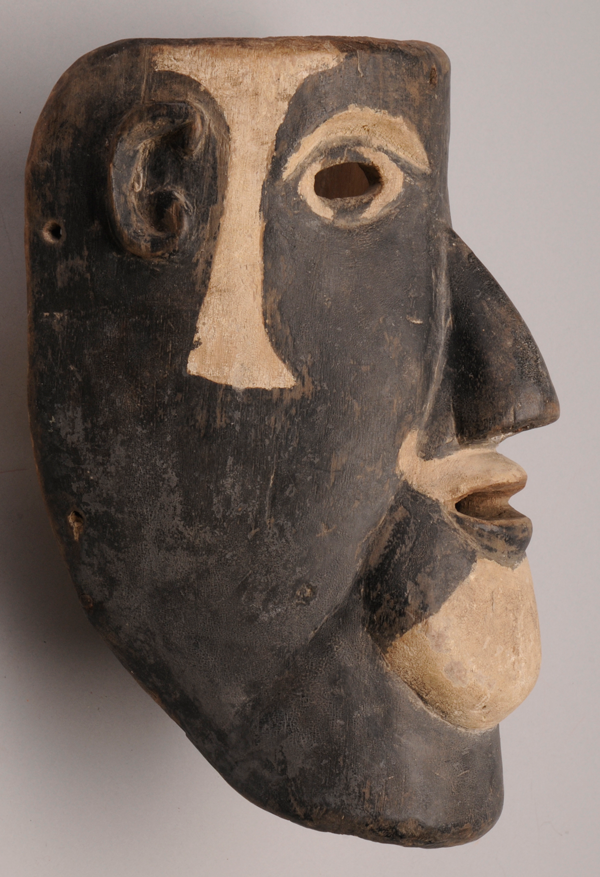
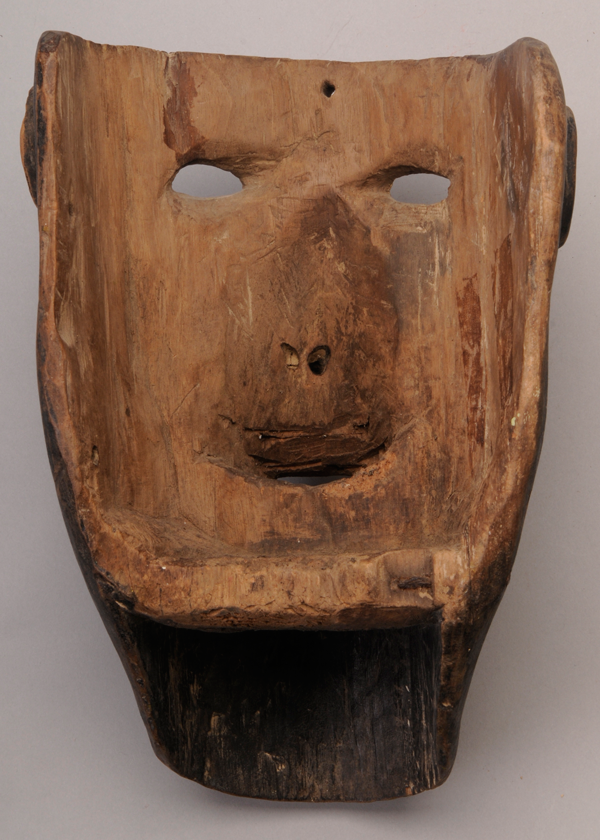
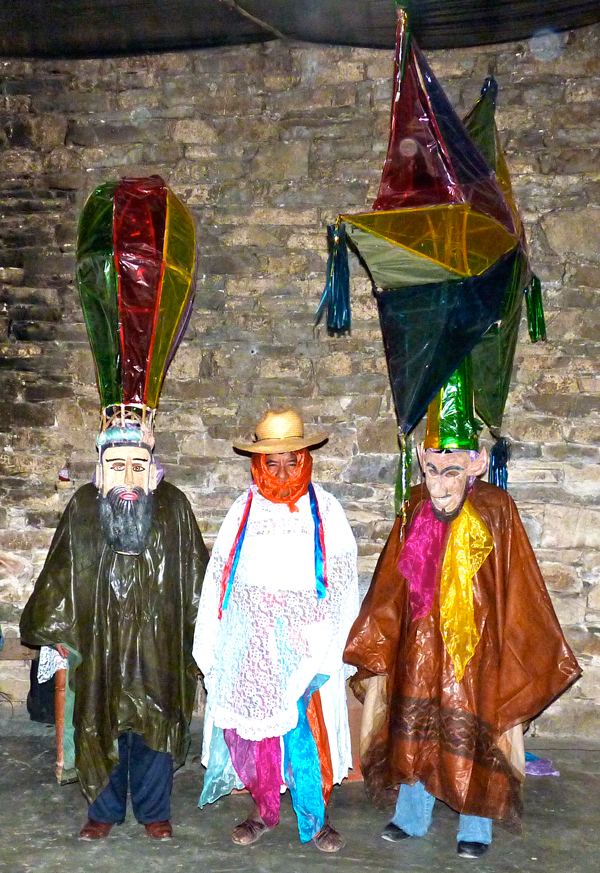
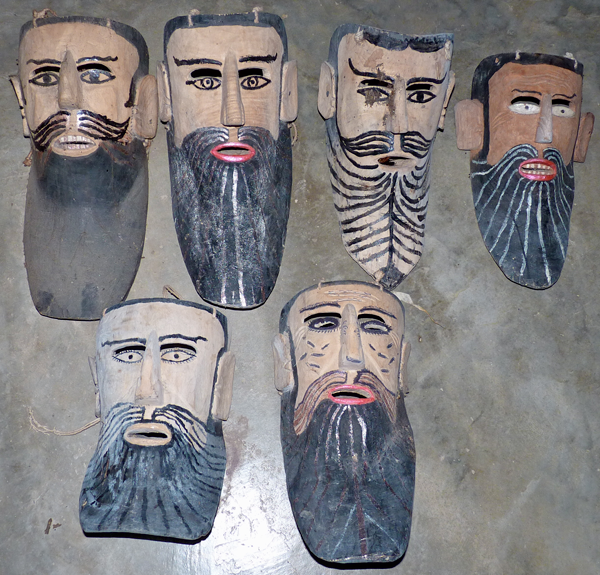
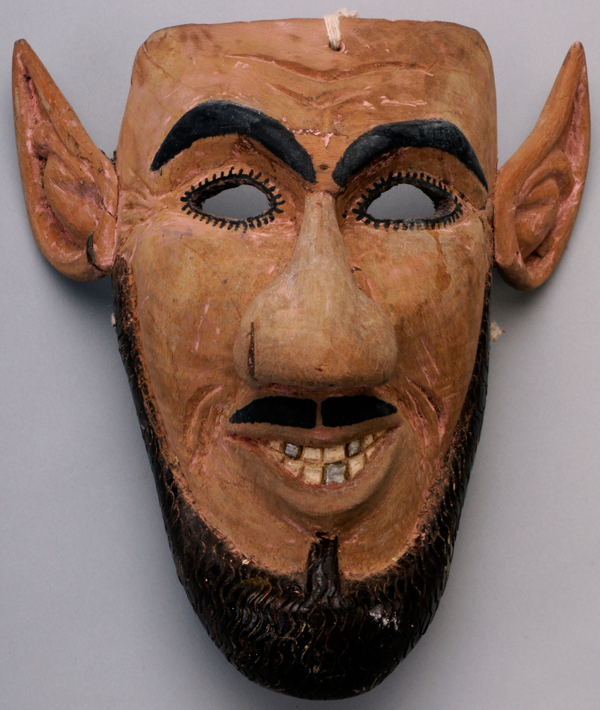
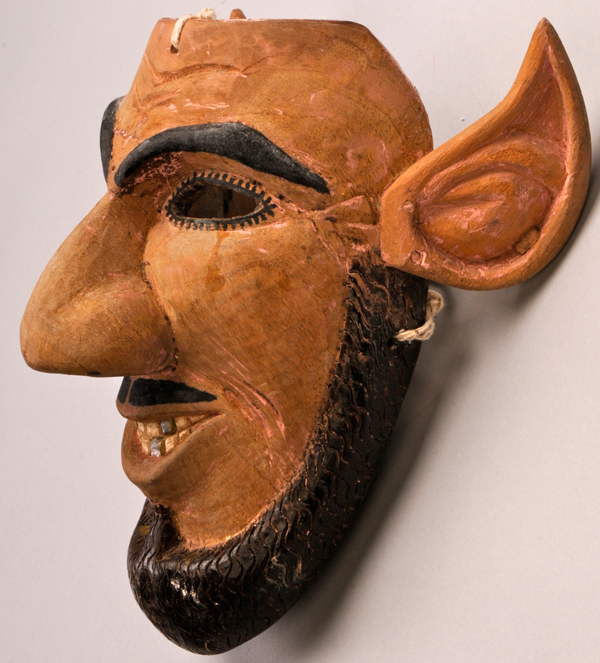

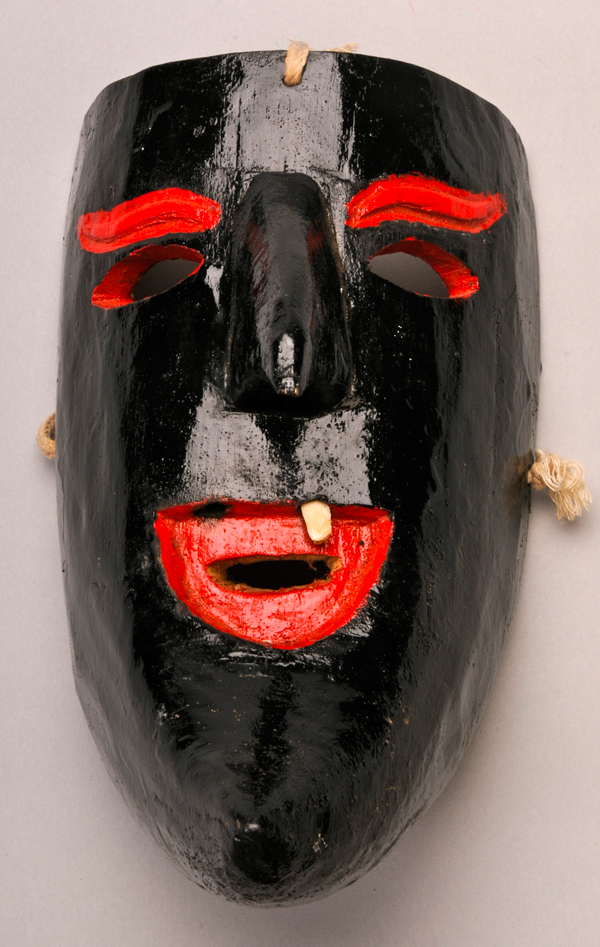
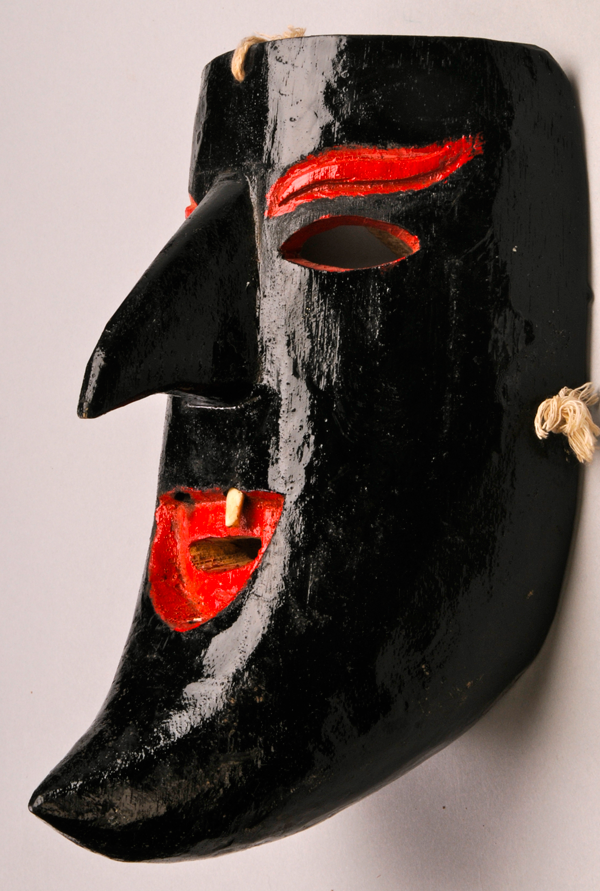
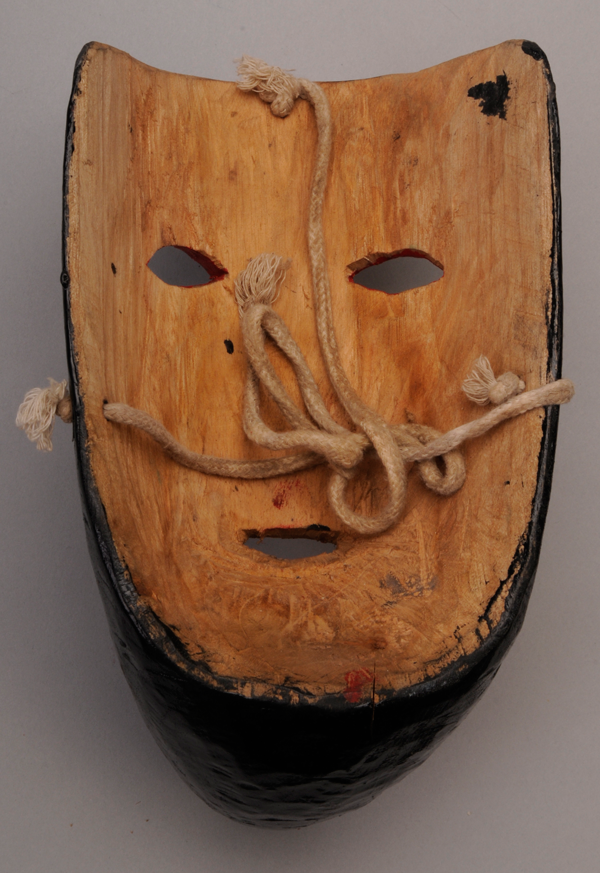
Hi! did you continue investigating this dance?
thanks,
Hello Libertad,
Yes and no. I attempted to summarize in this post about the Matarachines dance from what I had learned, and written about more broadly, in my Masks and Puppets book.
Briefly, a few larger points:
There was plenty of evidence to suggest that many of the persistent dances in the Sierra de Puebla region contain characters and elements that point to a persistent covert worship of the great Aztec god Tezcatlipoca, and that Satan was integrated into the Nahua dualistic religion as a manifestation of Tezcatlipoca, while Christ was also integrated into this dualism as another manifestation of those gods who oppose Tezcatlipoca. In other words, even tho the superficial appearances suggest that the Indians were rapidly and rather completely converted to Christianity, it seems more likely to me that they simply added Christian dieties into their polythiestic system.
I think this seemed absolutely natural and necessary to the Indians, because a. they were extremely frightened of Texcatlipoca and would not have thought of crossing him but b. their continued worship of pre-conquest gods was explicitly forbidden by the Priests.
In my book, I laid all this out in detail in a chapter about the religious context and I returned to speculate further in the afterword.
In the course of writing my book, I did ask a few wise older men about the persistence in modern times of such beliefs, and received blank looks. There was a very strong rejection of the ancient beliefs during the early 20th century, and apparently a lot of old fears went suddenly up in smoke, leaving traces in the dances but really having no persistent influence. The dances were in this way desecularized, I think, but maintained still and even revived as objects of pride re past traditions.
The more evidence I uncovered, the more fascinating I found it. Yet the evidence is difficult to corroberate in present times, and more formal scholars would shrink from going as far as I was willing to speculate.
Why did you ask? Were you particularly curious about some aspect.
My curiosity was sparked by the very weird portraits of Christ and the devil that emerge in these Sierra de Puebla dances- Satan elevated to be Christ’s equal, and portrayed as such a combined good guy/ bad guy, while Christ was essentially demoted to a more complex figure too. I concluded that the best explanation was that these to were no longer being treated from their traditional Christian perspective, but rather they had been adopted/coopted into the Mexican system of duality.
Thanks for asking.
Bryan Stevens